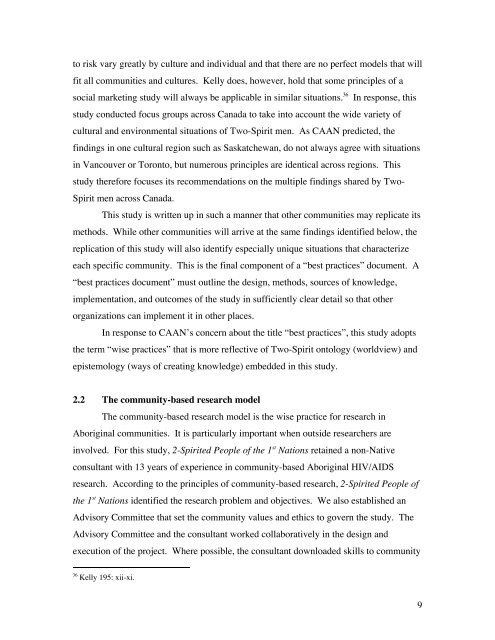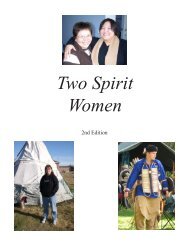Leading an Extraordinary Life: Wise Practices for an HIV ... - 2 Spirits
Leading an Extraordinary Life: Wise Practices for an HIV ... - 2 Spirits
Leading an Extraordinary Life: Wise Practices for an HIV ... - 2 Spirits
You also want an ePaper? Increase the reach of your titles
YUMPU automatically turns print PDFs into web optimized ePapers that Google loves.
to risk vary greatly by culture <strong>an</strong>d individual <strong>an</strong>d that there are no perfect models that will<br />
fit all communities <strong>an</strong>d cultures. Kelly does, however, hold that some principles of a<br />
social marketing study will always be applicable in similar situations. 36 In response, this<br />
study conducted focus groups across C<strong>an</strong>ada to take into account the wide variety of<br />
cultural <strong>an</strong>d environmental situations of Two-Spirit men. As CAAN predicted, the<br />
findings in one cultural region such as Saskatchew<strong>an</strong>, do not always agree with situations<br />
in V<strong>an</strong>couver or Toronto, but numerous principles are identical across regions. This<br />
study there<strong>for</strong>e focuses its recommendations on the multiple findings shared by Two-<br />
Spirit men across C<strong>an</strong>ada.<br />
This study is written up in such a m<strong>an</strong>ner that other communities may replicate its<br />
methods. While other communities will arrive at the same findings identified below, the<br />
replication of this study will also identify especially unique situations that characterize<br />
each specific community. This is the final component of a “best practices” document. A<br />
“best practices document” must outline the design, methods, sources of knowledge,<br />
implementation, <strong>an</strong>d outcomes of the study in sufficiently clear detail so that other<br />
org<strong>an</strong>izations c<strong>an</strong> implement it in other places.<br />
In response to CAAN’s concern about the title “best practices”, this study adopts<br />
the term “wise practices” that is more reflective of Two-Spirit ontology (worldview) <strong>an</strong>d<br />
epistemology (ways of creating knowledge) embedded in this study.<br />
2.2 The community-based research model<br />
The community-based research model is the wise practice <strong>for</strong> research in<br />
Aboriginal communities. It is particularly import<strong>an</strong>t when outside researchers are<br />
involved. For this study, 2-Spirited People of the 1 st Nations retained a non-Native<br />
consult<strong>an</strong>t with 13 years of experience in community-based Aboriginal <strong>HIV</strong>/AIDS<br />
research. According to the principles of community-based research, 2-Spirited People of<br />
the 1 st Nations identified the research problem <strong>an</strong>d objectives. We also established <strong>an</strong><br />
Advisory Committee that set the community values <strong>an</strong>d ethics to govern the study. The<br />
Advisory Committee <strong>an</strong>d the consult<strong>an</strong>t worked collaboratively in the design <strong>an</strong>d<br />
execution of the project. Where possible, the consult<strong>an</strong>t downloaded skills to community<br />
36 Kelly 195: xii-xi.<br />
9



